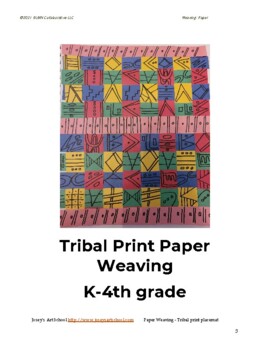Africa Kente Cloth Paper Weaving Art Lesson Montessori K to 4th Common Core
- PDF
Also included in
- This product introduces your students to four different styles of weaving. Weaving helps to develop fine motor skills, eye-hand coordination concentration and problem-solving skills. THIS LESSON COMPLIES WITH MANY ELA COMMON CORE STANDARDS You will receive 4 Art Projects:Paper Weaving Lesson MontPrice $10.99Original Price $15.76Save $4.77
Description
Are you looking for an engaging and culturally enriching lesson that will introduce your students to the vibrant art form of Kente cloth? Look no further than our Kente Cloth Paper Weaving Project!
In this lesson, your students will learn about the history and cultural significance of Kente cloth, a traditional textile from Ghana. They will explore the bold colors and intricate patterns that make Kente cloth so unique and create their own Kente cloth-inspired paper weaving project.
But that's not all! Here are four ways to integrate this lesson into other areas of your curriculum:
- Social Studies: Use this lesson as an opportunity to teach your students about the history and culture of Ghana. Encourage them to research and learn more about the traditions and customs of this fascinating country.
- Math: Weaving involves a variety of mathematical concepts, including pattern recognition, measurement, and spatial reasoning. Use this lesson to teach your students about these important mathematical concepts in a fun and engaging way.
- Language Arts: Have your students write a story or poem inspired by the colors and patterns of Kente cloth. Encourage them to use descriptive language to bring their writing to life.
- Art: Kente cloth is just one example of the many different types of textiles and weaving techniques found around the world. Use this lesson as a launching point to teach your students about the diversity and beauty of textiles from different cultures and regions.
With our Kente Cloth Paper Weaving Project, your students will develop important skills in art, design, and creativity while learning about the rich cultural traditions of Ghana. And with these integrated lesson ideas, you can incorporate these concepts into other areas of your curriculum, creating a more comprehensive and engaging learning experience for your students.
THIS LESSON COMPLIES WITH MANY ELA COMMON CORE STANDARDS
Continent: Africa
Art Project: Kente cloth
Brief lesson about the value of weaving
Perfect for a continent lesson extension in Montessori or traditional classroom
Perfect for practicing math and scissor skills
Perfect for a bonding, meditative practice
Perfect for teaching beginner weaving
CLICK HERE to view my freebies
CLICK HERE to view my DRAWING LESSONS
CLICK HERE to view my ART WITH THE MASTERS ART LESSONS
CLICK HERE to view my CONTEMPORARY ART LESSONS
CLICK HERE to view my ART LESSONS THAT COMPLIMENT POPULAR BOOKS
CLICK HERE to view my SELF ESTEEM PROJECTS
CLICK HERE to view my CLASS MURAL IDEAS
CLICK HERE to view my FUN ART FOLK ART LESSONS
CLICK HERE to view my 3 BUNDLED LESSONS
CLICK HERE to view my 5 BUNDLED LESSONS
Make sure to click the GREEN STAR near my store name so that you can stay in touch with my store. I create new lessons every week.






